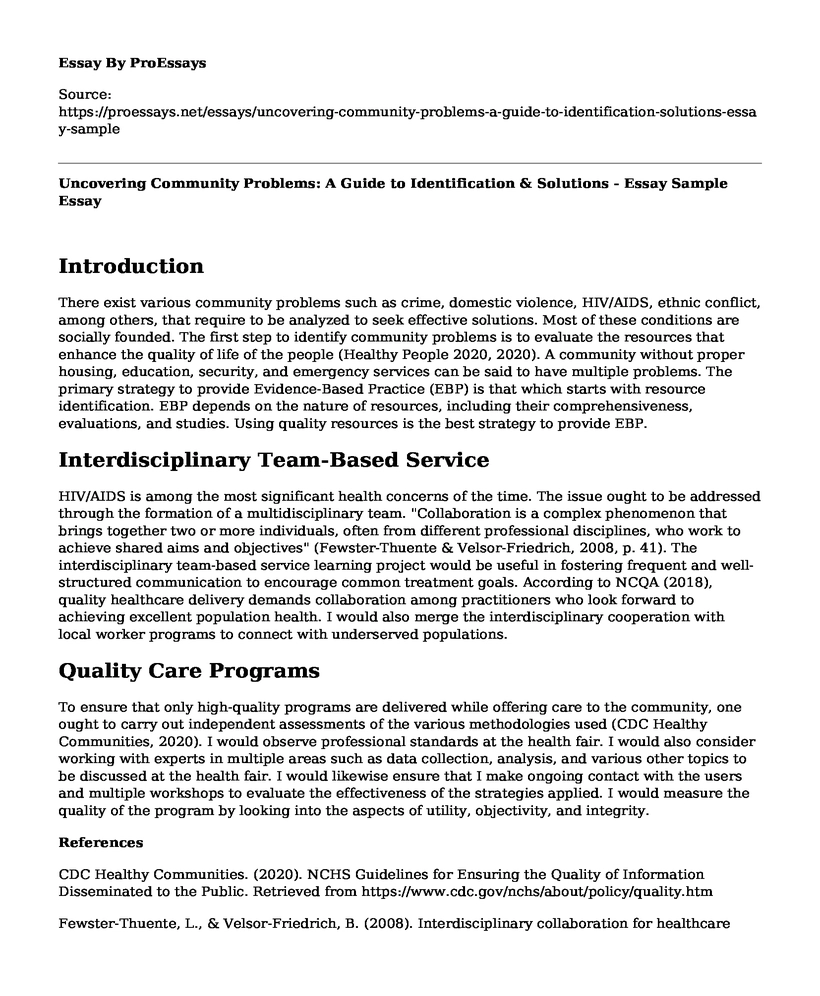Introduction
There exist various community problems such as crime, domestic violence, HIV/AIDS, ethnic conflict, among others, that require to be analyzed to seek effective solutions. Most of these conditions are socially founded. The first step to identify community problems is to evaluate the resources that enhance the quality of life of the people (Healthy People 2020, 2020). A community without proper housing, education, security, and emergency services can be said to have multiple problems. The primary strategy to provide Evidence-Based Practice (EBP) is that which starts with resource identification. EBP depends on the nature of resources, including their comprehensiveness, evaluations, and studies. Using quality resources is the best strategy to provide EBP.
Interdisciplinary Team-Based Service
HIV/AIDS is among the most significant health concerns of the time. The issue ought to be addressed through the formation of a multidisciplinary team. "Collaboration is a complex phenomenon that brings together two or more individuals, often from different professional disciplines, who work to achieve shared aims and objectives" (Fewster-Thuente & Velsor-Friedrich, 2008, p. 41). The interdisciplinary team-based service learning project would be useful in fostering frequent and well-structured communication to encourage common treatment goals. According to NCQA (2018), quality healthcare delivery demands collaboration among practitioners who look forward to achieving excellent population health. I would also merge the interdisciplinary cooperation with local worker programs to connect with underserved populations.
Quality Care Programs
To ensure that only high-quality programs are delivered while offering care to the community, one ought to carry out independent assessments of the various methodologies used (CDC Healthy Communities, 2020). I would observe professional standards at the health fair. I would also consider working with experts in multiple areas such as data collection, analysis, and various other topics to be discussed at the health fair. I would likewise ensure that I make ongoing contact with the users and multiple workshops to evaluate the effectiveness of the strategies applied. I would measure the quality of the program by looking into the aspects of utility, objectivity, and integrity.
References
CDC Healthy Communities. (2020). NCHS Guidelines for Ensuring the Quality of Information Disseminated to the Public. Retrieved from https://www.cdc.gov/nchs/about/policy/quality.htm
Fewster-Thuente, L., & Velsor-Friedrich, B. (2008). Interdisciplinary collaboration for healthcare professionals. Nursing administration quarterly, 32(1), 40-48.
Healthy People 2020. (2020). Evidence-Based Resource Summary. Retrieved from https://www.healthypeople.gov/2020/evidence-based-resource/health-professions
NCQA. (2018). Population Health Management - NCQA. Retrieved from https://www.ncqa.org/wp-content/uploads/2018/08/20180827_PHM_PHM_Resource_Guide.pdf
Cite this page
Uncovering Community Problems: A Guide to Identification & Solutions - Essay Sample. (2023, Apr 21). Retrieved from https://proessays.net/essays/uncovering-community-problems-a-guide-to-identification-solutions-essay-sample
If you are the original author of this essay and no longer wish to have it published on the ProEssays website, please click below to request its removal:
- Racial Democracy Essay
- Social Welfare Services and Standards of Practice in the Health Care Provision
- Communication Case Studies for Health Care Professionals Paper Example
- Trinity Community Hospital's Risk Assessment Paper Example
- Term Paper Example on Dialysis
- Family Dynamics: Its Influence on Personal Relationships - Essay Sample
- Essay Example on Alabama REACH 2010: Reducing Racial Disparities in Cervical & Breast Cancer







